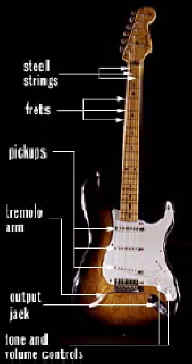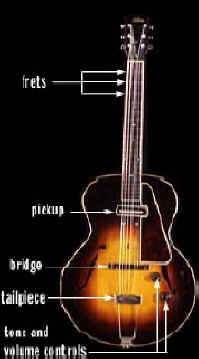| Solid-Body Electric Guitar As
makers and players continued to investigate ways of increasing the volume of the electric
guitar throughout the 1940s, it became clear that a solid body was a key design feature.
In a hollow guitar, the string's vibrations are transferred to the guitar's body. Since
the pickup cannot tell string and body vibrations
apart, the signal can be jumbled. In a solid-body guitar, the great mass of the
solid body has minimal response to the vibrations of the strings. So the pickup
"picks up" a cleaner signal of the strings' pure tone.
When the solid-body guitar is plugged into an amplifier, the electrical impulses created
by the pickups are converted into sound by the amplifier. Special-effects boxes, such as
the fuzz box that creates a distorted sound, can change the signal from the pickups, which
changes the sound that the amplifier produces. |

|

